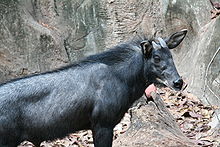Serow
| Serow[1] | |
|---|---|

| |
| Mainland serow(Capricornis sumatraensis) atDusit Zoo,Bangkok,Thailand. | |
| Scientific classification | |
| Domain: | Eukaryota |
| Kingdom: | Animalia |
| Phylum: | Chordata |
| Class: | Mammalia |
| Order: | Artiodactyla |
| Family: | Bovidae |
| Subfamily: | Caprinae |
| Tribe: | Ovibovini |
| Genus: | Capricornis Ogilby,1837 |
| Type species | |
| Antilope thar[1] Hodgson,1831
| |
| Species | |
|
Capricornis crispus | |
Theserow(/səˈroʊ/,or/ˈsɛroʊ/), is any of fourspeciesof medium-sizedgoat-like orantelope-like mammals in the genusCapricornis.All four species of serow were, until recently, classified underNaemorhedus,which now only contains thegorals.
Extant species[edit]
This genus has been analyzed, studied and reclassified a number of times. In 2005,Mammal Species of the World(3rd ed.) listed six different species (C. crispus,C. milneedwardsii,C. rubidus,C. sumatraensis,C. swinhoei,andC. thar), with two subspecies ofC. milneedwardsii.[1]The current consensus recognises the following four species, withmilneedwardsiiandthardemoted to subspecies ofC. sumatraensis:[2]
| Image | Scientific name | Common Name | Distribution |
|---|---|---|---|
 |
Capricornis crispus | Japanese serow | Honshu,Kyushu,andShikokuinJapan |
 |
Capricornis sumatraensis | Mainland serow | EasternHimalayas,eastern and southeasternBangladesh,China,Southeast Asia,and on theIndonesianisland ofSumatra |
 |
Capricornis rubidus | Red serow | East India,southern Bangladesh and northernMyanmar |
 |
Capricornis swinhoei | Taiwanor Formosan serow | Taiwan |
Serows live in south-central, southeast andeastern Asia.Their coloration varies by species, region, and individual. However, the different species are not particularlysexually dimorphic,as both males and females have beards and small horns (which are often shorter than their ears).
Like their smaller relatives, the gorals, serows are often found grazing on rocky and forested hillsides, though typically at a lower elevation in places where the two species'territoriesoverlap; gorals tend to be wary and typically retreat to higher elevations and steeper mountainsides. Serows are slightly larger and slower-moving, and somewhat less agile, than gorals; however, they can still nimbly climb up or down the slopes to escape predation or to find appropriate shelter during cold winters or hot summers. Serows, unlike gorals, make use of theirpreorbital glandsin territorial scent marking.
Fossils of serow-like animals date as far back as the latePliocene,two to seven million years ago. The common ancestor species of theCaprinaesubfamily may have been very similar to modern serows.
The serow subfamily population as a whole is considered endangered. Most serow species are included in the red list of IUCN with decreasing populations. The Japanese serow is better protected than the other sub-species of serows.[3][4][5][2]
References[edit]
- ^abcGrubb, P.(2005).Wilson, D. E.;Reeder, D. M. (eds.).Mammal Species of the World: A Taxonomic and Geographic Reference(3rd ed.). Baltimore, MD: Johns Hopkins University Press. pp. 703–705.ISBN0-8018-8221-4.OCLC62265494.
- ^abPhan, T.D.; Nijhawan, S.; Li, S. & Xiao, L. (2020)."Capricornis sumatraensis".IUCN Red List of Threatened Species.2020:e.T162916735A162916910.doi:10.2305/IUCN.UK.2020-2.RLTS.T162916735A162916910.en.Retrieved16 January2022.
- ^Shepard, C. (2022) [amended version of 2021 assessment]."Capricornis rubidus".IUCN Red List of Threatened Species.2022:e.T3815A214430673.doi:10.2305/IUCN.UK.2022-1.RLTS.T3815A214430673.en.Retrieved31 August2022.
- ^Tokida, K. (2020)."Capricornis crispus".IUCN Red List of Threatened Species.2020:e.T3811A22151909.doi:10.2305/IUCN.UK.2020-2.RLTS.T3811A22151909.en.Retrieved11 November2021.
- ^Chiang, P.J.; Pei, K.J-C. (2008)."Capricornis swinhoei".IUCN Red List of Threatened Species.2008:e.T3810A10096148.doi:10.2305/IUCN.UK.2008.RLTS.T3810A10096148.en.Retrieved19 November2021.
External links[edit]
- .Encyclopædia Britannica.Vol. 24 (11th ed.). 1911.
